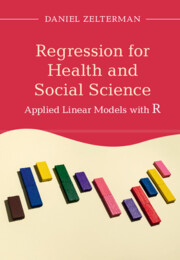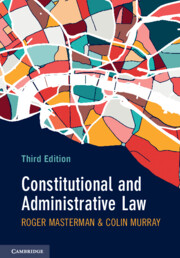Refine search
Actions for selected content:
36885 results in Cambridge Textbooks
Chapter 9 - The learner, embodied cognition and the affordance of learning environments
- from Part 3 - Learning, wellbeing and the ecology of learning environments
-
- Book:
- The Science of Learning and Development in Education
- Published online:
- 26 May 2022
- Print publication:
- 26 May 2022, pp 232-260
-
- Chapter
- Export citation
Chapter 4 - The active learner: Working memory, metacognition and brain research
- from Part 1 - The science of learning and development in the twenty-first century
-
- Book:
- The Science of Learning and Development in Education
- Published online:
- 26 May 2022
- Print publication:
- 26 May 2022, pp 84-111
-
- Chapter
- Export citation
How to use this book
-
- Book:
- The Science of Learning and Development in Education
- Published online:
- 26 May 2022
- Print publication:
- 26 May 2022, pp xviii-xx
-
- Chapter
- Export citation

Regression for Health and Social Science
- Applied Linear Models with R
-
- Published online:
- 20 May 2022
- Print publication:
- 12 May 2022
-
- Textbook
- Export citation

Constitutional and Administrative Law
-
- Published online:
- 19 May 2022
- Print publication:
- 02 June 2022
-
- Textbook
- Export citation

Ecotoxicology
-
- Published online:
- 19 May 2022
- Print publication:
- 19 May 2022
-
- Textbook
- Export citation
Chapter 11 - Complex Issues, Multiple Stressors and Lessons Learned
- from Part III - Complex Issues
-
-
- Book:
- Ecotoxicology
- Published online:
- 19 May 2022
- Print publication:
- 19 May 2022, pp 410-453
-
- Chapter
- Export citation
Chapter 8 - Endocrine Disrupting Chemicals
- from Part II - Toxicology of Individual Substances
-
-
- Book:
- Ecotoxicology
- Published online:
- 19 May 2022
- Print publication:
- 19 May 2022, pp 326-353
-
- Chapter
- Export citation
5 - Turbines
-
- Book:
- Essentials of Hydraulics
- Published online:
- 21 July 2022
- Print publication:
- 19 May 2022, pp 86-108
-
- Chapter
- Export citation
Chapter 6 - Metals and Metalloids
- from Part II - Toxicology of Individual Substances
-
-
- Book:
- Ecotoxicology
- Published online:
- 19 May 2022
- Print publication:
- 19 May 2022, pp 170-273
-
- Chapter
- Export citation
13 - Spillways and Gates
-
- Book:
- Essentials of Hydraulics
- Published online:
- 21 July 2022
- Print publication:
- 19 May 2022, pp 231-250
-
- Chapter
- Export citation
Notation
-
- Book:
- Essentials of Hydraulics
- Published online:
- 21 July 2022
- Print publication:
- 19 May 2022, pp xvii-xx
-
- Chapter
- Export citation
Epilogue: A Final Perspective
-
- Book:
- Ecotoxicology
- Published online:
- 19 May 2022
- Print publication:
- 19 May 2022, pp 551-554
-
- Chapter
- Export citation
Dedication
-
- Book:
- Essentials of Hydraulics
- Published online:
- 21 July 2022
- Print publication:
- 19 May 2022, pp v-vi
-
- Chapter
- Export citation
References
-
- Book:
- Essentials of Hydraulics
- Published online:
- 21 July 2022
- Print publication:
- 19 May 2022, pp 326-335
-
- Chapter
- Export citation
Preamble
-
- Book:
- Ecotoxicology
- Published online:
- 19 May 2022
- Print publication:
- 19 May 2022, pp xv-xvi
-
- Chapter
- Export citation
Acknowledgements
-
- Book:
- Ecotoxicology
- Published online:
- 19 May 2022
- Print publication:
- 19 May 2022, pp xix-xix
-
- Chapter
- Export citation
Part IV - Management
-
- Book:
- Ecotoxicology
- Published online:
- 19 May 2022
- Print publication:
- 19 May 2022, pp 454-455
-
- Chapter
- Export citation
15 - Geohydrology
-
- Book:
- Essentials of Hydraulics
- Published online:
- 21 July 2022
- Print publication:
- 19 May 2022, pp 277-294
-
- Chapter
- Export citation
14 - Hydrology
-
- Book:
- Essentials of Hydraulics
- Published online:
- 21 July 2022
- Print publication:
- 19 May 2022, pp 251-276
-
- Chapter
- Export citation
